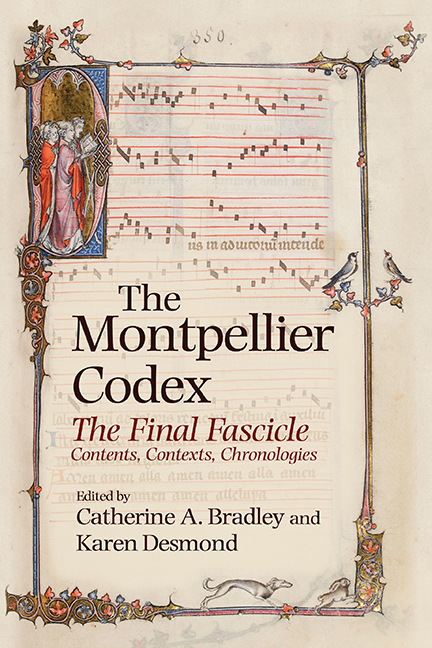Book contents
- Frontmatter
- Contents
- Figures
- Musical examples
- Tables
- Acknowledgements
- List of manuscript sigla
- Abbreviations
- Table of fascicle 8 contents
- Introduction
- I The Material Object
- 1 Montpellier 8: Anatomy of …
- 2 A Palaeographical Analysis of the Verbal Text in Montpellier 8: Problems, Implications, Opportunities
- 3 The Style and Iconography of Montpellier folio 35or
- 4 The Decoration of Montpellier 8: Its Place in the Continuum of Parisian Manuscript Illumination
- 5 Double Motet Layouts in the Montpellier Codex and Contemporaneous Libri motetorum
- 6 Deus in adiutorium Revisited: Sources and Contexts
- 7 Thematic Clusters and Compilational Strategies in Montpellier 8
- II INNOVATION AND TRADITION
- III ANALYTICAL CASE STUDIES
- Bibliography
- Contributors
- General index
- Index of compositions, alphabetical
- Index of compositions in Mo, manuscript order
- Miscellaneous Endmatter
1 - Montpellier 8: Anatomy of …
from I - The Material Object
Published online by Cambridge University Press: 04 July 2019
- Frontmatter
- Contents
- Figures
- Musical examples
- Tables
- Acknowledgements
- List of manuscript sigla
- Abbreviations
- Table of fascicle 8 contents
- Introduction
- I The Material Object
- 1 Montpellier 8: Anatomy of …
- 2 A Palaeographical Analysis of the Verbal Text in Montpellier 8: Problems, Implications, Opportunities
- 3 The Style and Iconography of Montpellier folio 35or
- 4 The Decoration of Montpellier 8: Its Place in the Continuum of Parisian Manuscript Illumination
- 5 Double Motet Layouts in the Montpellier Codex and Contemporaneous Libri motetorum
- 6 Deus in adiutorium Revisited: Sources and Contexts
- 7 Thematic Clusters and Compilational Strategies in Montpellier 8
- II INNOVATION AND TRADITION
- III ANALYTICAL CASE STUDIES
- Bibliography
- Contributors
- General index
- Index of compositions, alphabetical
- Index of compositions in Mo, manuscript order
- Miscellaneous Endmatter
Summary
THE later parts of the Montpellier codex are fascinating in so many ways. First of all, the complexity of exactly how these later parts – the seventh fascicle, the two appendices or supplements for the seventh fascicle, and the eighth fascicle – relate to each other is in itself a conundrum; second, these later fascicles and their supplements effortlessly hurdle the entirely false chronological barrier of 1300 erected by the term ‘thirteenth-century motet’; and, third, the later parts of the manuscript contain such a profusion, an abundance, a cornucopia, of different types of work. This essay brings together for the first time answers to the most important questions that might be asked about Mo 8. Some of these relate to topics addressed elsewhere in this volume, but in most other cases, sketching out the questions and drafting answers is this essay's purpose. The title of this chapter could well allude to Otto Preminger's 1959 classic film Anatomy of a Murder, with a stellar performance by James Stewart and an equally stellar score by Duke Ellington and Billy Strahorn, music that has been recognized for its effective alignment of various strands in Ellington's late oeuvre. Alternatively, it might reference the 2006 album The Anatomy of by the thrash metal band Between the Buried and Me, which covers more than a dozen classics from Pink Floyd, through King Crimson and Metallica, to The Smashing Pumpkins and Counting Crows. But actually, anatomy, tout court, describes what Mo 8 needs, as well as defining music that brings various traditions into alignment and that provides, in some cases, ‘covers’ of medieval classics: disassembling the component parts of the corpus and setting them out on a stainless steel dissecting table – a tenor here, a refrain there, a group of ‘Petronian’ semibreves over there – at which a dispassionate look may be taken, and of which some sense can begin to be made.
Recent work on the subject of the history of Mo in its entirety has shown that Robert Branner's 1977 re-shading of Friedrich Ludwig and Yvonne Rokseth's views remains largely accepted. Ludwig and Rokseth – for different reasons and probably independently – proposed that the first six fascicles of the manuscript constituted its corpus ancien or alte Corpus, while the seventh fascicle was later and the eighth even later still, perhaps as late as the early fourteenth century.
- Type
- Chapter
- Information
- The Montpellier CodexThe Final Fascicle. Contents, Contexts, Chronologies, pp. 13 - 31Publisher: Boydell & BrewerPrint publication year: 2018
- 19
- Cited by

